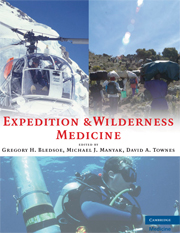Book contents
- Frontmatter
- Contents
- Contributors
- Foreword
- Preface
- Acknowledgments
- PART I EXPEDITION PLANNING
- PART II EXPEDITIONS IN UNIQUE ENVIRONMENTS
- PART III ILLNESS AND INJURIES ON EXPEDITIONS
- 24 General Medical
- 25 The Diarrhea of Travelers
- 26 Malaria: Diagnosis, Prevention, and Treatment for the Traveler
- 27 Wild Animal Attacks and Injuries
- 28 Snake and Arthropod Envenoming
- 29 Hazardous Marine Life
- 30 Expedition Toxicology
- 31 Environmental Injuries
- 32 Penetrating and Explosive Wounds
- 33 Drowning and Submersion Injury
- 34 Evaluation and Acute Resuscitation of the Trauma Patient
- 35 Principles and Practice of Expedition Wound Management
- 36 Expedition Eye Injuries and Disorders
- 37 Dental Medicine on Expedition
- 38 Foot Injuries
- 39 Expedition Orthopedics
- 40 Expedition Self-Rescue and Evacuation
- 41 Aeromedical Evacuations
- APPENDIX The Expedition Medical Kit
- Index
27 - Wild Animal Attacks and Injuries
from PART III - ILLNESS AND INJURIES ON EXPEDITIONS
Published online by Cambridge University Press: 05 March 2013
- Frontmatter
- Contents
- Contributors
- Foreword
- Preface
- Acknowledgments
- PART I EXPEDITION PLANNING
- PART II EXPEDITIONS IN UNIQUE ENVIRONMENTS
- PART III ILLNESS AND INJURIES ON EXPEDITIONS
- 24 General Medical
- 25 The Diarrhea of Travelers
- 26 Malaria: Diagnosis, Prevention, and Treatment for the Traveler
- 27 Wild Animal Attacks and Injuries
- 28 Snake and Arthropod Envenoming
- 29 Hazardous Marine Life
- 30 Expedition Toxicology
- 31 Environmental Injuries
- 32 Penetrating and Explosive Wounds
- 33 Drowning and Submersion Injury
- 34 Evaluation and Acute Resuscitation of the Trauma Patient
- 35 Principles and Practice of Expedition Wound Management
- 36 Expedition Eye Injuries and Disorders
- 37 Dental Medicine on Expedition
- 38 Foot Injuries
- 39 Expedition Orthopedics
- 40 Expedition Self-Rescue and Evacuation
- 41 Aeromedical Evacuations
- APPENDIX The Expedition Medical Kit
- Index
Summary
Wild animal attacks are a unique subset of injuries. Multiple injuries in any combination occur such as extensive complex lacerations and puncture wounds, crush injuries, evisceration, and blunt trauma. In addition to the challenge of managing these in less than ideal environments, there is often a hysteria that goes along with these types of attacks. Mainstream news headlines such as the mauling and subsequent eating of the “Grizzly Man” Timothy Treadwill and his girlfriend by bears in Alaska; Steve Irwin's unnerving demise after a “freak” accident involving a stingray (AP, 2006); and the tiger attack on Roy of Siegfried and Roy have served to feed into public misunderstanding of wild creatures and their behaviors (Marquez, 2003; Herzog, 2005). In this chapter, we will explore prevention, management, and treatment of bites and injuries inflicted by large and small mammals, herbivores, predators, large birds, reptiles, and hazardous aquatic life.
EPIDEMIOLOGY
In the United States, 2 million to 4.5 million animal bites occur annually. Only 1% of these require hospitalization. The majority of these reported bites are dogs (80–85%) and cats (10%), with other animals (rodents, rabbits, horses, raccoons, bats, skunks, and monkeys) making up the remaining 5–10% (2006).
A study done in the United States estimated 177 animal-related fatalities a year (excluding zoonotic infections and animal–vehicle collisions), and 61% of these fatalities were caused by nonvenomous animals. The majority of these cases were caused by “other specified animal” on chart review.
- Type
- Chapter
- Information
- Expedition and Wilderness Medicine , pp. 373 - 395Publisher: Cambridge University PressPrint publication year: 2008

